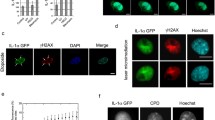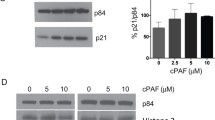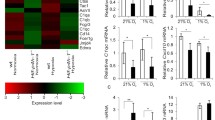Abstract
Hypoxia inducible factor-1α (HIF-1α), a ubiquitous inducible oxygen-sensing transcription factor, promotes cell survival under hypoxic conditions, including the early pre-angiogenic period of tumorigenesis, and is known to contribute to many malignancies. However HIF-1α can also be activated by inflammatory mediators, and can activate inflammation-modulating proteins itself, including heme oxygenase-1 (HO-1) and the cytokine IL-6. Recently HIF-1α was reported to be induced by UVB (290–320 nm) radiation in cultured human keratinocytes, acting as a stress protein associated with the release of reactive oxygen species. In this in vivo murine study we demonstrate that HIF-1α protein is an early responder to UV radiation in the skin, and its activation can be attenuated by treating mice with its post-translational inhibitor, YC-1. Treatment with YC-1 following UV-irradiation of mice has revealed the involvement of HIF-1α in UV-induced inflammation, IL-6 production, and epidermal hyperplasia. In addition, upregulated cutaneous HIF-1α was found to be an important factor in the UV-suppression of T cell-mediated immunity, measured by contact hypersensitivity (CHS). The mechanism remains unclear, however it did not appear to involve the immunosuppressive cutaneous photoproduct cis-urocanic acid, but HIF-1α induction was inhibited by irradiation with photoimmune protective UVA (320–400 nm), implicating a negative correlation between the two stress proteins, HIF-1α and the photoimmune protective UVA responder HO-1.
Similar content being viewed by others
References
K. S. Choi, M. K. Bae, J. W. Jeong, H. E. Moon, K. W. Kim, Hypoxia-induced angiogenesis during carcinogenesis. Review, J. Biochem. Mol. Biol., 2003, 36, 120–127.
E. J. Yeo, Y. S. Chun, Y. S. Cho, J. Kim, J. C. Lee, M. S. Kim, J. W. Park, YC-1: A potential anticancer drug targeting hypoxia-inducible factor-1, J. Natl. Cancer Inst., 2003, 95, 516–525.
E. J. Yeo, Y. S. Chun, J. W. Park, New anticancer strategies targeting HIF-1, Biochem. Pharmacol., 2004, 68, 1061–1069.
T. Hellwig-Burgel, D. P. Stiehl, A. E. Wagner, E. Metzen, W. Jelkmann, Hypoxia-inducible factor-1 (HIF-1): A novel transcription factor in immune reactions, J. Interferon Cytokine Res., 2005, 25, 297–310.
G. L. Semenza, Signal transduction to hypoxia-inducible factor-1, Biochem. Pharmacol., 2002, 64, 993–998.
H. J. Jeong, H. S. Chung, B. R. Lee, S. J. Kim, S. J. Yoo, S. H. Hong, H. M. Kim, Expression of proinflammatory cytokines via HIF-1α and NF-κB activation on desferrioxamine-stimulated HMC-1 cells, Biochem. Biophys. Res. Commun., 2003, 306, 805–811.
H. J. Jeong, S. H. Hong, R. K. Park, T. Shin, N. H. An, H. M. Kim, Hypoxia-induced IL-6 production is associated with activation of MAP kinase, HIF-1, and NF-κB on HEI-OC1 cells, Hear. Res., 2005, 207, 59–67.
S. H. Lee, Y. J. Lee, H. J. Han, Effect of arachidonic acid on hypoxia-induced IL-6 production in mouse ES cells: Involvement of MAPKs, NF-κB, and HIF-1α, J. Cell Physiol., 2010, 222, 574–585.
Z. N. Rabbani, J. Mi, Y. Zhang, M. Delong, I. L. Jackson, K. Fleckstein, F. K. Salahuddin, X. Zhang, B. Clary, M. S. Anscher, Z. Vujaskvic, Hypoxia-inducible factor-1α signaling in fractionated radiation-induced lung injury: role of oxidative stress and tissue hypoxia, Radiat. Res., 2010, 173, 165–174.
J. Rius, M. Guma, C. Schachtrup, K. Akassoglou, A. S. Zinkernagel, V. Nizet, R. S. Johnson, G. G. Haddad, M. Karin, NF-κB links innate immunity to the hypoxic response through transcription regulation of HIF-1α, Nature, 2008, 453, 807–811.
G. Czibik, J. Sagave, V. Martinov, B. Ishaq, M. Sohl, I. Sefland, H. Carlsen, F. Farnebo, R. Blomhoff, G. Valen, Cardioprotection by hypoxia-inducible factor-1α transfection in skeletal muscle is dependent on haem oxygenase activity in mice, Cardiovasc. Res., 2009, 82, 107–114.
B. Dawn, R. Bolli, HO-1 induction by HIF-1: a new mechanism for delayed cardioprotection? Review, Am. J. Physiol., 2005, 289, H522–524.
P. J. Lee, B. H. Jiang, B. Y. Chin, N. V. Iyer, J. Alam, G. L. Semenza, A. M. K. Choi, Hypoxia-inducible factor-1 mediates transcriptional activation of the heme oxygenase-1 gene in response to hypoxia, J. Biol. Chem., 1997, 272, 5375–5381.
R. Natarajan, F. N. Salloum, B. J. Fisher, E. D. Ownby, R. C. Kukreja, A. A. Fowler, 3rd, Activation of hypoxia-inducible factor-1 via prolyl-4 hydroxylase-2 gene silencing attenuates acute inflammatory responses in postischemic myocardium, Am. J. Physiol.: Renal Physiol., 2007, 293, H1571–1580.
R. Ockaili, R. Natarajan, F. Salloum, B. J. Fisher, D. Jones, A. A. Fowler III, R. C. Kukreja, HIF-1 activation attenuates postischemic myocardial injury: role for heme oxygenase-1 in modulating microvascular chemokine generation, Am. J. Physiol., 2005, 289, H542–548.
M. Zampino, M. Yuzhakova, J. Hansen, R. D. McKinney, P. H. Goldspink, D. L. Geenan, P. M. Buttrick, Sex-related dimorphic response of HIF-1α expression in myocardial ischemia, Am. J. Physiol.: Cell Physiol., 2006, 291, H957–964.
R. M. Tyrrell, V. E. Reeve, Potential protection of skin by acute UVA irradiation-From cellular to animal models. Review, Prog. Biophys. Mol. Biol., 2006, 92, 86–91.
B. Li, K. Takeda, S. Yokoyama, S. Shibahara, A prolyl-hydroxylase inhibitor, ethyl-3,4-dihydroxybenzoate, induces haem oxygenase-1 expression in human cells through a mechanism independent of hypoxia-inducible factor-1α, J. Biochem., 2008, 144, 643–654.
A. Loboda, A Stachurska, U. Florczyk, D. Rudnicka, A. Jazwa, J. Wegrzyn, M. Kozakowska, K. Stalinska, L. Peollinger, A. L. Levonen, S. Yla-Herttuala, A. Jozkowicz, J. Dulak, HIF-1 induction attenuates Nrf2-dependent IL-8 expression in human endothelial cells, Antioxid. Redox Signaling, 2009, 11, 1501–1517.
M. Scortegagna, C. Cataisson, R. J. Martin, D. J. Hicklin, R. D. Schreiber, S. H. Yuspa, J. M. Arbeit, HIF-1α regulates epithelial inflammation by cell autonomous NF-κB activation and paracrine stromal remodelling, Blood, 2008, 111, 3343–3354.
M. G. Schwacha, E. Nickel, T. Daniel, Burn injury-induced alterations in wound inflammation and healing are associated with suppressed hypoxia inducible factor-1α expression, Mol. Med., 2008, 14, 628–633.
C. Rosenberger, C. Solovan, A. D. Rosenberger, L. Jinping, R. Treudler, U. Frei, K. U. Eckardt, L. F. Brown, Upregulation of hypoxia-inducible factors in normal and psoriatic skin, J. Invest. Dermatol., 2007, 127, 2445–2452.
Y. S. Cho, J. M. Bae, Y. S. Chun, J. H. Chung, Y. K. Jeon, I. S. Kim, M. S. Kim, J. W. Park, HIF-1α controls keratinocyte proliferation by up-regulating p21 (WAF1/Cip1), Biochim. Biophys. Acta, Mol. Cell Res., 2008, 1783, 323–333.
L. Wunderlich, G. Paragh, G. Wikonkal, G. Babhegyi, S. Karpati, J. Mandl, UVB induced a biphasic response of HIF-1α in cultured human keratinocytes, Exp. Dermatol., 2008, 17, 335–342.
H. R. Rezvani, F. Mazurier, M. Cario-Andre, C. Pain, C. Ged, A. Taieb, H. De Verneuil, Protective effects of catalase overexpression on UVB-induced apoptosis in normal human keratinocytes, J. Biol. Chem., 2006, 281, 17999–18007.
H. R. Rezvani, S. Dedieu, S. North, F. Belloc, R. Rossignol, T. Letellier, H. De Verneuil, A. Taieb, F. Mazurier, Hypoxia-inducible factor-1α, a key factor in the keratinocyte response to UVB exposure, J. Biol. Chem., 2007, 282, 16413–16422.
T. Cramer, Y. Yamanishi, B. E. Clausen, I. Forster, R. Pawlinski, N. Mackman, V. H. Haase, R. Jaenisch, M. Corr, V. Nizet, G. S. Firestein, H. P. Gerber, N. Ferrara, R. S. Johnson, HIF-1α is essential for myeloid cell-mediated inflammation, Cell, 2003, 112, 645–657.
V. Nizet, R. Johnson, Interdependence of hypoxic and innate immune responses, Nat. Rev. Immunol., 2009, 9, 609–617.
H. Kurobe, M. Urata, M. Ueno, M. Ueki, S. Ono, Y. Izawa-Ishizawa, Y. Fukuhara, Y. Lei, A. M. Ripen, T. Kanbara, K. Aihara, K. Ishizawa, M. Akaike, F. J. Gonzalez, T. Tamaki, Y. Takahama, M. Yoshizumi, T. Kitagawa, S. Tomita, Role of hypoxia-inducible factor-1α in T cells as a negative regulator in development of vascular remodelling, Arterioscler., Thromb., Vasc. Biol., 2010, 30, 210–217.
F. N. Ko, C. C. Wu, S. C. Kuo, F. Y. Lee, C. M. Teng, YC-1, a novel activator of platelet guanylate cyclase, Blood, 1994, 84, 4226–4233.
Y. S. Chun, E. J. Yeo, J. W. Park, Versatile pharmacological actions of YC-1: anti-platelet to anticancer. Review, Cancer Lett., 2004, 207, 1–7.
M. De Niro, O. Alsmadi, F. Al-Mohanna, Modulating the hypoxia-inducible factor signalling pathway as a therapeutic modality to regulate retinal angiogenesis, Exp. Eye Res., 2009, 89, 700–717.
A. Loboda, A. Jozkowicz, J. Dulak, HIF-1 and HIF-2 transcription factors-similar but not identical, Mol. Cells, 2010, 29, 435–442.
J. D. Gordan, M. C. Simon, Hypoxia-inducible factors: central regulators of the tumor phenotype, Curr. Opin. Genet. Dev., 2007, 17, 71–72.
L. Turchi, E. Aberdam, N. Mazure, J. Pouyssegur, M. Decker, S. Kitajima, D. Aberdam, T. Virolle, Hif-2alpha mediates UV-induced apoptosis through a novel ATF3-dependent death pathway, Cell Death Differ., 2008, 15, 1472–1480.
J. L. Cho, M. Allanson, D. Domanski, S. J. Arun, V. E. Reeve, Estrogen receptor-beta signalling protects epidermal cytokine expression and immune function from UVB-induced impairment in mice, Photochem. Photobiol. Sci., 2008, 7, 120–125.
V. E. Reeve, D. Domanski, M. Slater, Radiation sources providing increased UVA/UVB ratios induce photoprotection dependent on the UVA dose in hairless mice, Photochem. Photobiol., 2006, 82, 406–411.
Y. Ibuki, M. Allanson, K. M. Dixon, V. E. Reeve, Radiation sources providing increased UVA/UVB ratios attenuate the apoptotic effects of the UVB waveband UVA-dose-dependently in hairless mouse skin, J. Invest. Dermatol., 2007, 127, 2236–2244.
O. H. Lowry, N. J. Rosebrough, A. L. Farr, R. J. Randall, Protein measurement with the Folin phenol reagent, J. Biol. Chem., 1951, 193, 265–275.
J. S. Kang, Y. D. Yoon, K. H. Lee, S. K. Park, H. M. Kim, Costunolide inhibits interleukin-1β expression by downregulation of AP-1 and MAPK activity in LPS-stimulated RAW 264.7 cells, Biochem. Biophys. Res. Commun., 2004, 313:, 171–177.
N. Cole, P. W. Sou, A. Ngo, K. H. Tsang, J. A. J. Severino, S. J. Arun, C. C. Duke, V. E. Reeve, Topical ‘Sydney’ propolis protects against UV-radiation-induced inflammation, lipid peroxidation and immune suppression in mouse skin, Int. Arch. Allergy Immunol., 2010, 152, 87–97.
V. E. Reeve, R. M. Tyrrell, M. Allanson, D. Domanski, L. Blyth, The role of interleukin-6 in UVA protection against UVB-induced immunosuppression, J. Invest. Dermatol., 2008, 129, 1539–1546.
V. E. Reeve, Ultraviolet radiation and the contact hypersensitivity reaction in mice, Methods, 2002, 28, 20–24.
V. E. Reeve, R. M. Tyrrell, Heme oxygenase induction mediates the photoimmunoprotective activity of UVA radiation in the mouse, Proc. Natl. Acad. Sci. U. S. A., 1999, 96, 9317–9321.
X. M. Liu, K. J. Peyton, N. N. Mendelev, H. Wang, D. A. Tulis, W. Durante, YC-1 stimulates the expression of gaseous monoxide-generating enzymes in vascular smooth muscle cells, Mol. Pharmacol., 2009, 75, 208–217.
M. Allanson, D. Domanski, V. E. Reeve, Photoimmunoprotection by UVA (320-400 nm) radiation is determined by UVA dose and is associated with cutaneous cyclic guanosine monophosphate, J. Invest. Dermatol., 2006, 126, 191–197.
Y. Liu, N. Christou, T. Morita, E. Laughner, G. L. Semenza, S. Kourembanas, Carbon monoxide and nitric oxide suppress the hypoxic induction of vascular endothelial growth factor gene via the 5′ enhancer, J. Biol. Chem., 1998, 273, 15257–15262.
T. Tsuruda, K. Hatakeyama, H. Masuyama, Y. Seikita, T. Imamura, Y. Asada, K. Kitamura, Pharmacological stimulation of soluble guanylate cyclase modulates hypoxia-inducible factor-1α in rat heart, Am. J. Physiol., 2009, 297, H1274–1280.
E. A. Nickel, C. H. Hsieh, J. G. Chen, M. G. Schwacha, I. H. Chaudry, Estrogen suppresses cardiac IL-6 after trauma-hemorrhage via a hypoxia-inducible factor-1α-mediated pathway, Shock, 2009, 31, 354–358.
S. E. Ullrich, Sunlight and skin cancer: Lessons from the immune system, Mol. Carcinog., 2007, 46, 629–633.
C. S. Sreevidya, A. Fukunaga, N. M. Khaskhely, T. Masaki, R. Ono, C. Nishigori, S. E. Ullrich, Agents that reverse UV-induced immune suppression and photocarcinogenesis affect DNA repair, J. Invest. Dermatol., 2010, 130, 1428–1437.
N. G. Bazan, R. Palacios-Pelaez, W. J. Lukiw, Hypoxia signalling to genes: Significance in Alzheimer’s disease, Mol. Neurobiol., 2002, 26, 283–298.
C. Michiels, T. Arnould, J. Remade, Endothelial cell responses to hypoxia: initiation of a cascade of cellular interactions. Review, Biochim. Biophys. Acta, Mol. Cell Res., 2000, 1497, 1–10.
T. Kitamuro, K. Takahashi, K. Ogawa, R. Udomo-Fujimori, K. Takeda, K. Furuyama, M. Nakayama, J. Sun, H. Fujita, W. Hida, T. Hattori, K. Shirato, K. Igarashi, S. Shibara, Bach1 functions as a hypoxia-inducible repressor for the heme oxygenase-1 gene in human cells, J. Biol. Chem., 2003, 278, 9125–9135.
A Jazwa, A. Loboda, S. Golda, J. Cisowski, M. Szelag, A. Zagorska, P. Sroczynska, J. Drukala, A. Jozkowicz, J. Dulak, Effect of heme oxygenase-1 on vascular endothelial growth factor synthesis and angiogenic potency of human keratinocytes, Free Radical Biol. Med., 2006, 40, 1250–1263.
M. Scortegagna, R. J. Martin, R. D. Kladney, R. G. Neumann, Hypoxia-inducible factor-1α suppresses squamous carcinogenic progression and epithelial-mesenchymal transition, Cancer Res., 2009, 69, 2638–2646.
Author information
Authors and Affiliations
Corresponding author
Rights and permissions
About this article
Cite this article
Cho, JL., Allanson, M. & Reeve, V.E. Hypoxia inducible factor-1α contributes to UV radiation-induced inflammation, epidermal hyperplasia and immunosuppression in mice. Photochem Photobiol Sci 11, 309–317 (2012). https://doi.org/10.1039/c1pp05265a
Received:
Accepted:
Published:
Issue Date:
DOI: https://doi.org/10.1039/c1pp05265a




